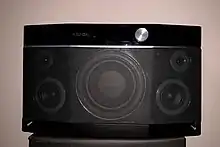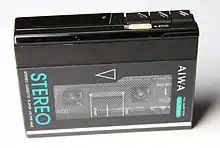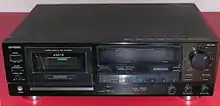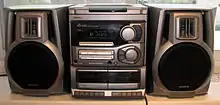Aiwa
Aiwa (アイワ) is a consumer electronics brand owned and used by various companies in different regions of the world. American and other regions are owned by Chicago-based Aiwa Corporation. Towada Audio based in Tokyo owns rights in Japan and elsewhere and has been manufacturing Aiwa-branded products since 2017. In Mexico and other countries in Latin America, rights are owned by Audio Mobile Americas, S.A.
Aiwa logo from 1991 to 2003, and since 2015 | |
| Industry | Consumer electronics |
|---|---|
| Founded | 1951 ((original) as AIKO Denki Sangyo Co., Ltd.) 1959 (as Aiwa Co., Ltd.) 2015 ((relaunch) as Aiwa Corp.) 2017 (as new Aiwa Co., Ltd.) |
| Defunct | 2002 (original) |
| Headquarters | Taito, Tokyo (1951–2002) Chiyoda, Tokyo (2002–2006) Chicago, Illinois (as Aiwa USA; 2015–) Kosaka, Akita (as Aiwa Co., Ltd.; 2017–) |
Key people | Joe Born (CEO; Aiwa USA) |
| Products | |
| Parent | Independent (1951–1982; 2015–) Sony Corporation (1982–2006) Towada Audio (2017–) |
| Website | Aiwa Corporation (USA) Aiwa Co., Ltd.(Japan) Audio Mobile Americas (Mexico) |



Aiwa was founded in 1951 and was once a globally well-regarded brand known for making quality audio products such as speakers, boomboxes and stereo systems.[1] It was the market leader in several product categories. Aiwa created the first Japanese cassette tape recorder in 1964.[2] The company was listed on the Tokyo Stock Exchange from October 1961 until September 2003.
The company became unprofitable in the late 1990s, and was fully bought by Sony in 2003. Aiwa was then rebranded as a new youth-focused division of Sony, but it was unsuccessful and the brand was discontinued by 2006. In 2015, an American audio company known as Hale Devices, Inc. was granted the rights to the brand name, with the company renaming itself Aiwa Corporation and starting to produce audio equipment.[3]
History

The company was founded on June 20, 1951, as AIKO Denki Sangyo Co., Ltd., manufacturing microphones, and changed its name to Aiwa Co., Ltd. (アイワ株式会社), on March 10, 1959.[4] Mitsuo Ikejiri served as president until 1969.
The company was a leading manufacturer of audio products, including headphone stereos, minicomponent stereo systems, portable stereo systems, minidisc players, CD and cassette players, and car stereo systems throughout the 1970s, 1980s, and 1990s.[5][6] Nearly 86 percent of company revenues were derived from such audio products. 12 percent came from products such as televisions and VCRs, and the remaining two percent from computer peripherals and other life products.
Aiwa marketed Japan's first boombox, the TPR-101, in 1968, as well as the first cassette deck, TP-1009. In 1980, Aiwa created the world's first personal stereo recorder, TP-S30. Despite Sony being the major shareholder, healthy competition between the two brands was believed to be profitable.[7] In 1990, Aiwa created the HP-J7 earbuds, designed to be vertically inserted into the ear. In 1993, the first CD+G-compatible portable CD player, the XP-80G, was made.
Apart from audio products, Aiwa also has been present in other industries. The company also made and sold video products such as VCRs, color televisions, DVD players, and digital satellite television tuners. Aiwa was also involved in the production of computer peripheral devices, such as modems, terminal adapters, and speakers, and what the company termed "life amenity products," such as air cleaners and humidifiers. In 1995, it released a PHS mobile phone, called the PT-H50, which was made for the DDI Pocket network in Japan.[8] That same year, an electric toothbrush, the HA-C10, was released.
Aiwa manufactured more than 89 percent of its output outside Japan, with a heavy emphasis on the lower-cost southeast Asian nations of Singapore, Malaysia, and Indonesia. The company was also heavily dependent on overseas sales, with more than 80 percent of total revenues being generated outside Japan, with 43 percent in North and South America, 25 percent in Europe, and 13 percent in areas of Asia outside Japan and in other regions.
Although not then officially an affiliated company of consumer electronics giant Sony Corporation, by 1982, Sony had a 54.6% stake in the company, effectively giving it a majority control.[9]
With growing competition throughout the late 1990s, the company slid towards bankruptcy. In March 2001, the company's president, Masayoshi Morimoto, announced the halving of its workforce, following a second consecutive loss–making year.[10]
Acquisition by Sony
The troubled company was then fully purchased by Sony Corporation.[11] As of December 31, 2003, Aiwa ceased to be a separate company and became a wholly owned division of Sony.[12]
In January 2004, Sony announced the rebranding and relaunch of Aiwa as a "youth focused, PC-centric" electronics brand.[13] A new logo was presented to the world's media along with a statement of Sony's intention to invest in and "revitalize" the Aiwa brand. The direction proposed was to capitalize on the growing trend among personal-computer-literate teenagers and young adults to use their PCs for all forms of entertainment (television, films, music, chat). It was also used to expand in markets where Sony is not as strong.
However the new direction of Aiwa under Sony did not meet consumer and sales expectations. On January 21, 2005, new product development ended, and by 2006, Aiwa products were discontinued and no longer sold in the market. Sony announced the termination of the brand entirely on May 14, 2008.[14]
As of January 2014, the Aiwa website still existed to provide customer-support telephone numbers for some territories and regions, but it also contained many broken links and blank pages. In other regions, such as Europe, it redirected to a page on the Sony website stating that the Aiwa website had closed.[15]
Aiwa USA (2015–)
In 2015, Dormitus Brands, a Chicago-based brand acquisition company run by Mark Thomann, acquired the trademark right in the U.S. Thomann looked to pair the brand with a company that was innovating in the audio industry, eventually leading to a deal with Hale Devices, Inc., headed by Joe Born. Hale Devices renamed itself into Aiwa. The Aiwa brand was formally relaunched in March 2015, releasing its first product, the Exos-9, a wireless Bluetooth speaker.[16]
Aiwa Co., Ltd. (2017–)
On April 11, 2017, Japanese audio equipment manufacturer Towada Audio announced that Towada acquired Aiwa brand rights from Sony and would produce Aiwa-branded audio and record player products.[17]
Products
Products of Aiwa include music centres, Hi-Fi, compact disc players, boombox radios and portable CD players.
Stereo Cassette Players
- HS-P06 Produced in 1984. Shipped with TU-01 FM/AM Stereo Tuner Pack [18]
Logos
The first logo of the company contained AIWA in capital letters, in use until 1991. The second logo changed the font to a lowercase one, as aiwa. In 2004, after the acquisition by Sony, the logo was rebranded as part of Sony's efforts to 'revitalize' the brand, and was in use until the brand's retirement in 2006. Since the brand's resurrection in 2015, the second (1991–2003) logo is back in use. All logos were colored red.
Gallery
 AIWA CA-W30 dual cassette boombox
AIWA CA-W30 dual cassette boombox Aiwa AM-XH55 MiniDisc player
Aiwa AM-XH55 MiniDisc player AIWA AR-888 AM receiver
AIWA AR-888 AM receiver Aiwa CSD-ES100 compact CD/radio/cassette recorder
Aiwa CSD-ES100 compact CD/radio/cassette recorder AIWA AD WX 333 cassette deck
AIWA AD WX 333 cassette deck Aiwa XR-H330 MD micro system (1999)
Aiwa XR-H330 MD micro system (1999) Aiwa TV-A2017S 21" television
Aiwa TV-A2017S 21" television Aiwa S7000 cassette recorder
Aiwa S7000 cassette recorder Aiwa CM-S32 microphone
Aiwa CM-S32 microphone AIWA TPR-950 boombox
AIWA TPR-950 boombox Aiwa XR-FD55 micro system
Aiwa XR-FD55 micro system.jpg.webp) AIWA AR-852 8-transistor radio
AIWA AR-852 8-transistor radio_Radio%252C_Model_AR-127._Made_In_Japan%252C_Circa_1964_(12887691514).jpg.webp) AIWA AR-127 10-transistor dual band radio (c. 1964)
AIWA AR-127 10-transistor dual band radio (c. 1964)%252C_Made_In_Japan_(May_Be_Model_AR-123)_(12886883044).jpg.webp) AIWA AR-123 10-transistor triple band radio
AIWA AR-123 10-transistor triple band radio.jpg.webp) AIWA Sound GT earphone (c. 1990s)
AIWA Sound GT earphone (c. 1990s) Aiwa stereo system
Aiwa stereo system Aiwa CSD-MD3 compact CD/cassette/radio/MiniDisc player
Aiwa CSD-MD3 compact CD/cassette/radio/MiniDisc player Aiwa loudspeaker enclosure
Aiwa loudspeaker enclosure Aiwa CDC-R176M car CD/radio receiver (c. mid-1990s)
Aiwa CDC-R176M car CD/radio receiver (c. mid-1990s) Aiwa XR-V10MD micro system with MD/DVD support
Aiwa XR-V10MD micro system with MD/DVD support Aiwa TP-32A
Aiwa TP-32A
See also
References
| Wikimedia Commons has media related to AIWA. |
- "Aiwa: The Almost Great Audio Company". Gizmodo.com. September 16, 2011. Retrieved August 19, 2020.
- "History of Aiwa Co., Ltd. – FundingUniverse". Fundinguniverse.com. Retrieved August 19, 2020.
- http://www.chicagobusiness.com/article/20150423/ISSUE01/150429976/can-the-guy-who-hit-it-with-an-android-alarm-dock-do-it-again-with-stereo-speakers%5B%5D
- "Aiwa Co., Ltd. History". FundingUniverse.com. Retrieved March 31, 2015.
- Andy Madden (March 18, 2015). "Aiwa returns with the Exos-9 Bluetooth speaker". What Hi-Fi? Sound and Vision. Haymarket Media Group. Retrieved March 31, 2015.
- "Aiwa". HomeTheaterReview.com. Luxury Publishing Group Inc. Retrieved March 31, 2015.
- "Aiwa | Vintage Electronics Have Soul – The Pocket Calculator Show Website". Pocketcalculatorshow.com. Retrieved August 19, 2020.
- "Aiwa PT-H50". Mobilecollectors.net. Retrieved August 19, 2020.
- "The giants in Japanese electronics". The Economist. February 20, 1982. Retrieved March 31, 2015.
- "CNN.com - Aiwa slashes workforce in half - March 26, 2001". Edition.cnn.com. March 26, 2001. Retrieved August 19, 2020.
- Adrian Covert (September 16, 2011). "Aiwa: The Almost Great Audio Company". Gizmodo. Gawker Media. Retrieved March 31, 2015.
- "Sony leverages Aiwa to compete against Chinese suppliers". EE Times. August 14, 2020. Retrieved August 19, 2020.
- Mark Sweney (February 14, 2004). "Sony in talks with London shops about global Aiwa creative brief". Brand Republic. Haymarket Media Group. Retrieved March 31, 2015.
- "Archived copy". Archived from the original on September 11, 2016. Retrieved August 11, 2016.CS1 maint: archived copy as title (link)
- "Find out about AIWA Support: Official Information from Sony". Sony Europe. Sony. Retrieved June 9, 2012.
- John Carpenter (March 11, 2015). "How Aiwa, a former global stereo brand, is getting resurrected in Chicago". Chicago Tribune. Retrieved March 31, 2015.
- "Aiwa Co., Ltd". Jp-aiwa.com. Retrieved August 19, 2020.
- "Aiwa Service Manual Stereo Cassette Player with FM/AM Stereo Tuner Pack Model No. HS-P06". Aiwa – via freeservicemanuls.info. Cite journal requires
|journal=(help) - "XP-ZV610/ZV616 Portable CD Player Operating Instructions" (PDF). Aiwa: 23. Archived from the original (PDF) on August 14, 2020. Retrieved August 14, 2020 – via manualslib.com. Cite journal requires
|journal=(help)
External links
- Aiwa Corporation (USA)
- Aiwa Co., Ltd. (Japan)
- Aiwa site as a Sony division
- Aiwa closure message
- Aiwa India

